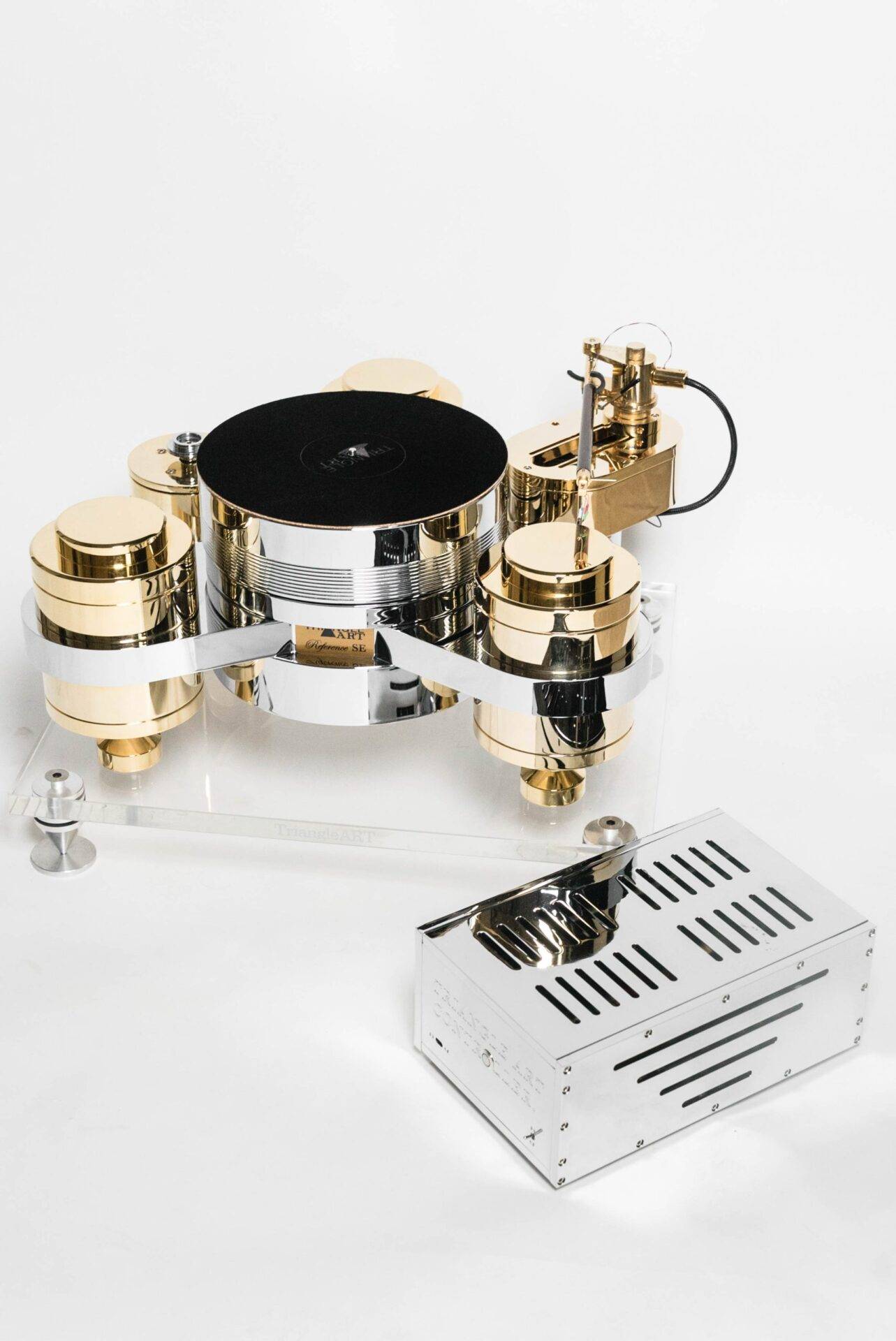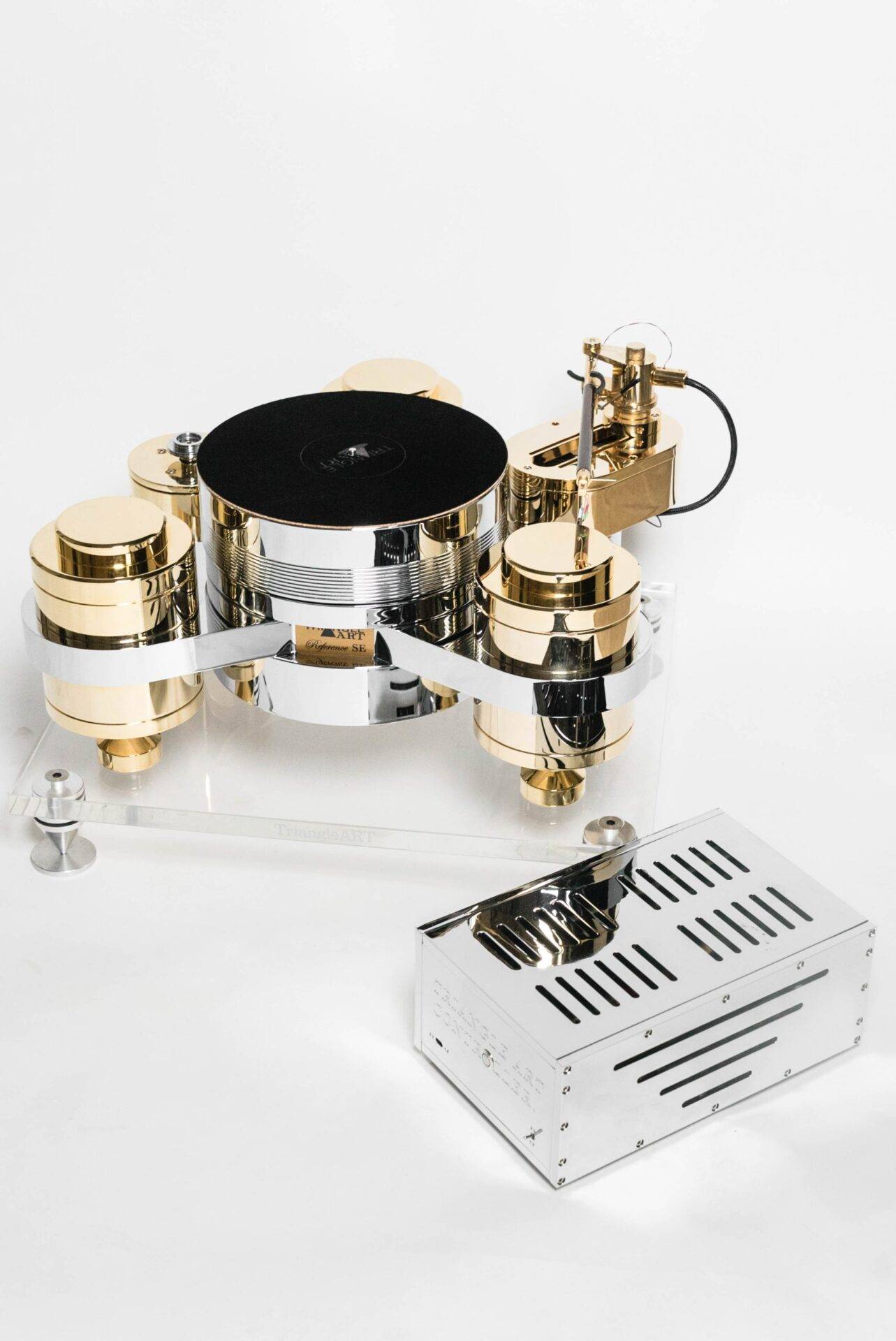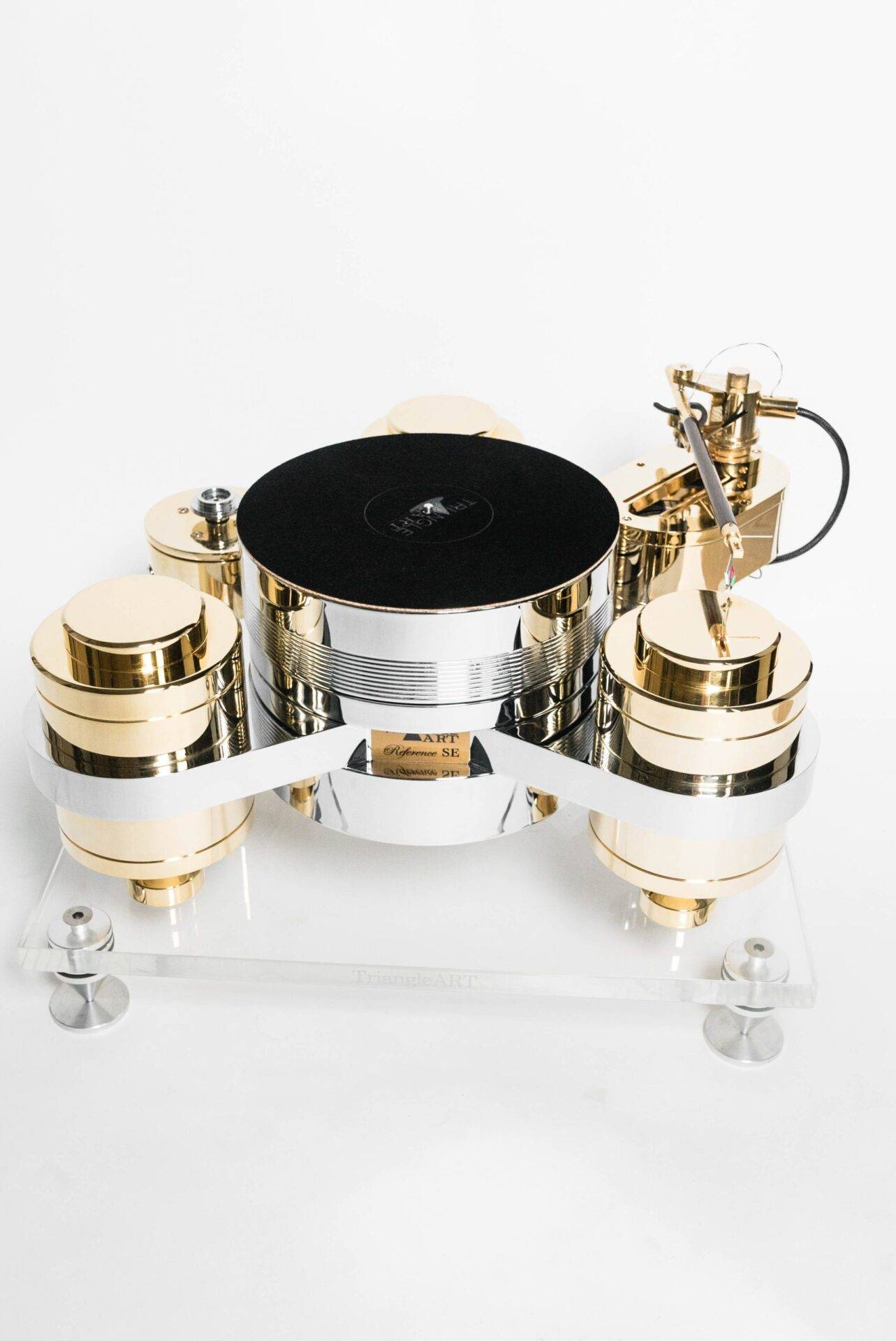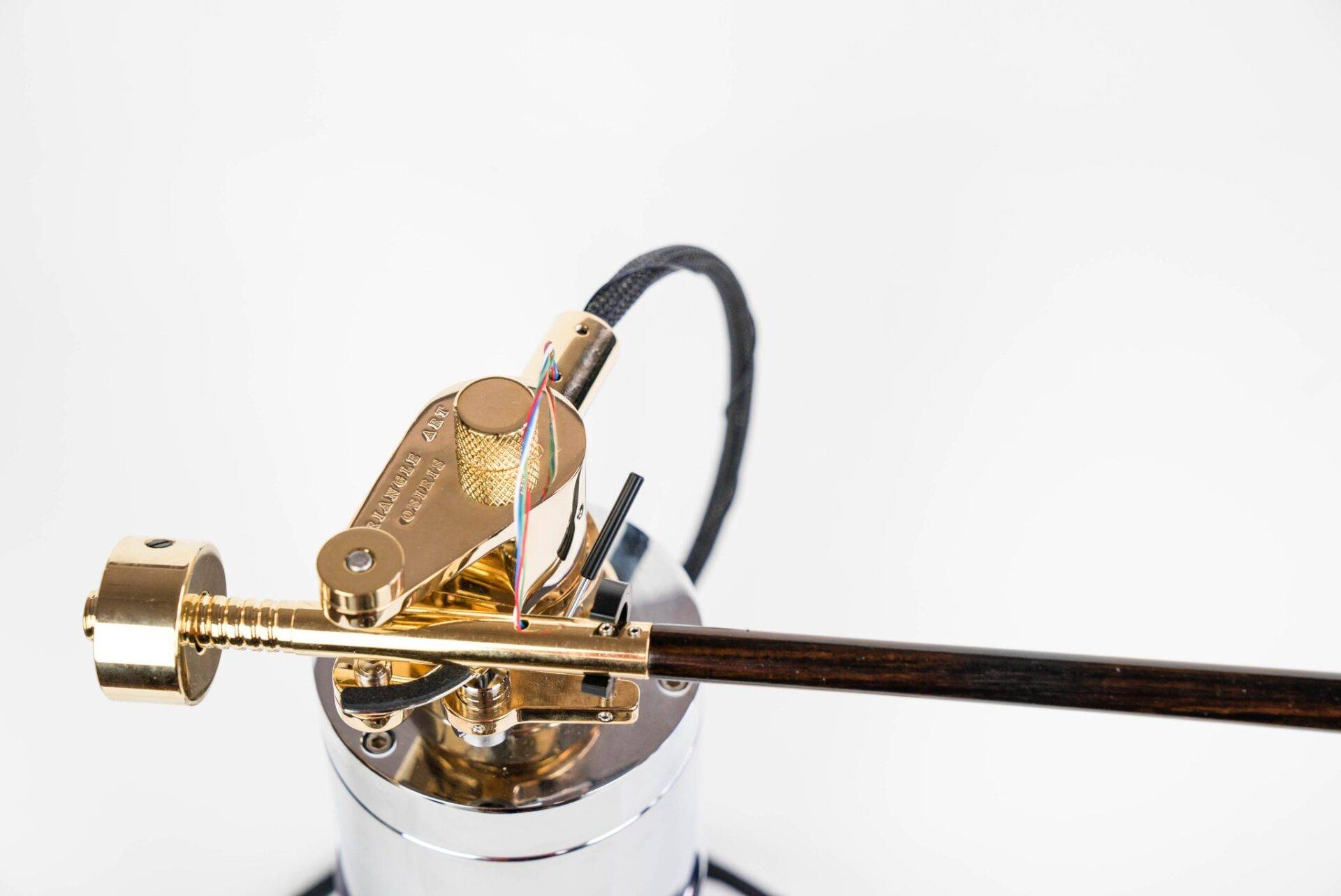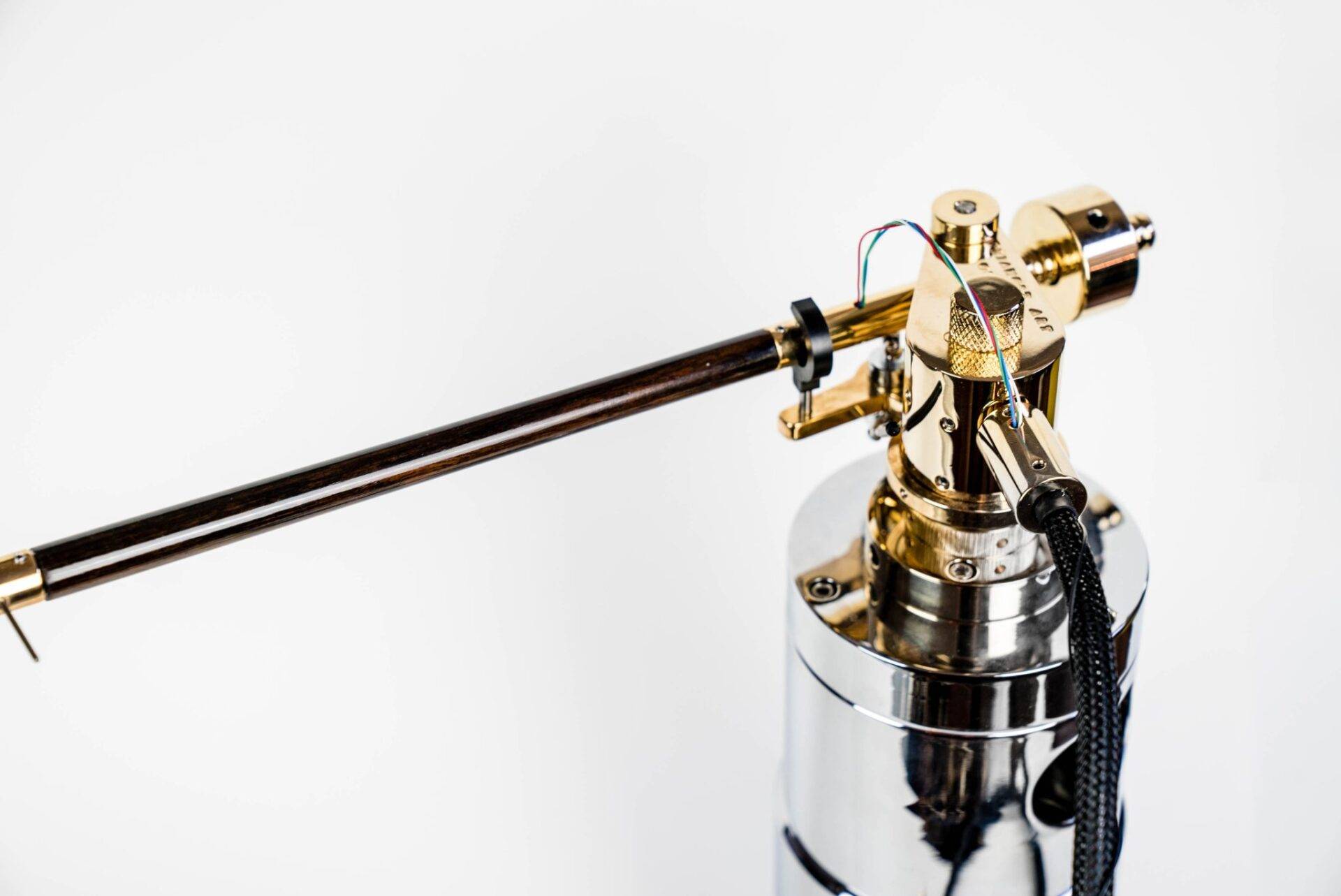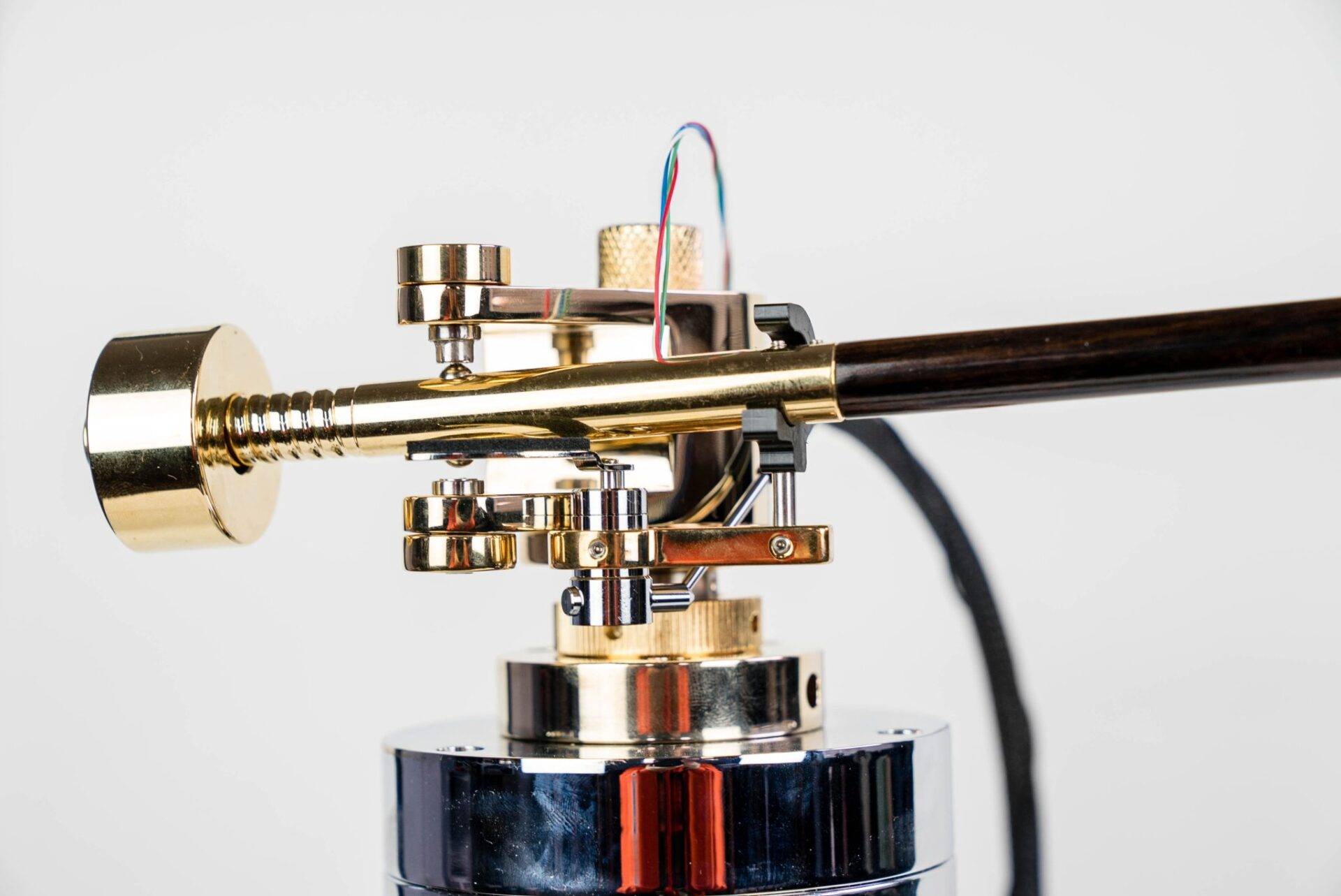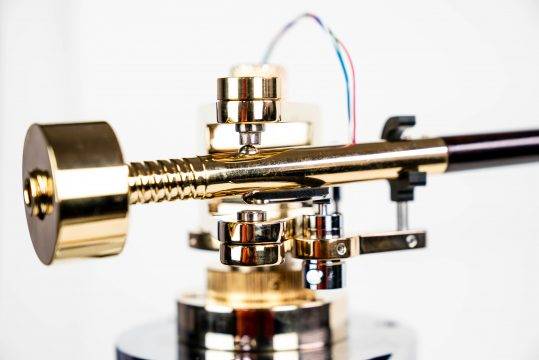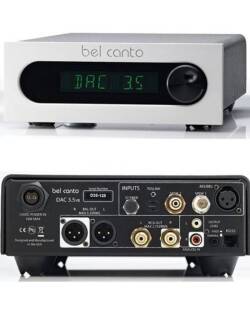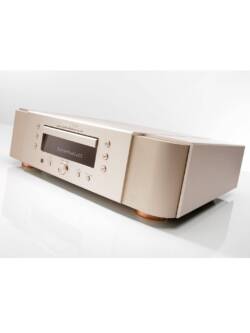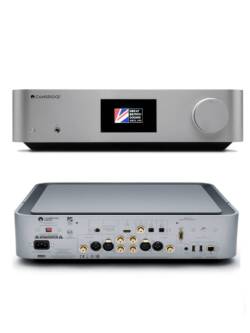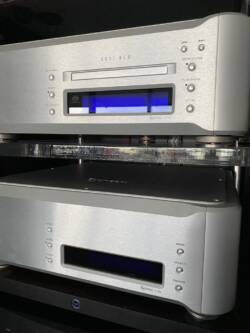Triangle Art Reference SE with Osiris Mk2 Tonearm (Only one in SA)
Original price was: R650,000.00.R250,000.00Current price is: R250,000.00.
Osiris mk2 Specifications:
After experiments with different woods and other various materials, we found a peculiar combination of Makassar Ebony and brass that yielded a much more sonorous musical quality. The OSIRIS Tonearm juggles physics, materials, and the sixth sense of music, arriving at qualities in sound best described as ethereal – as Osiris herself.
Named after the Egyptian goddess who brought life from ashes, we too propose to reinvigorate your LP collection with the gorgeous, living sound produced by the magnetically suspended OSIRIS Tonearm bearing.
Unipivot Magnetic Bearing Tonearm
Magnetic Anti-SkatingMakassar
Ebony wood armtube (in 9″ or 12″)
Solid brass housing so responsive to the musicality and details
Cryo .9999 fine silver continuous pick-up arm wire with RCA connectors
Bearing Magnet which employs the rare-earth Neodymium, one of the strongest permanent magnets known On-the-fly VTA adjustment Easy turn able Counterweight for
VTF (Vertical Tracking Force) with locking screw Different lengths 9 “, 12
“Overhand 9″ is 216 mm and 12″ is 298 mm
Effective mass 15-35 grams
Cartridge range 6-18g
Triangle ART Reference SE:
REFERENCE SE Beyond the physical features of the TriangleART products, there are intrinsic aspects of these turntables worth noting, qualities which are not understood until someone meets the turntable in person to discover: 1) the manufacturer’s dedication and love of the undisturbed musical experience, producing ecstasy for the music lover, and 2) mastery of the engineering and aesthetics of the high end turntable.
Triangle Art Reference SE Table is our latest in turntable development. After years of researching materials, suspensions, bearings, platters and motor designs, we have invented a better turntable
through our design research we upgraded some of the metals employed for parts. The all-gold components result in a much more appealing, elegant and harmonious sonic quality, imparting a sweet, refined texture to the playback.
Reference SE is a massive turntable, weighing in at 275 pounds. Reference SE comes with a hefty solid composite metal with a 3 inches thick platter made of solid composite metal, used to control and dampen all vibrations for better resonance (more below). Non-inverted steel ball bearings with diamond coating support the heavy platter while still providing an intensely quiet and smooth as liquid performance. The jet-black background of this turntable reproduces every soft, inner details with subtle micro and macro dynamics, presenting a tight and articulate bass while projecting a holographic image and a light, airy sound stage.
Platter:
The embedded platter is made of a unique composite material, and is one of the largest in the marketplace.
Bearing:
Bearing runs on a thrust washer, and is made from stainless steel hard shaft with diamond coating. This special material has a very low efficient of friction and very high wears resistance, resulting in a long, maintenance-free life.
Motor:
The heavy composite metal motor housing comes with a new interior AC motor to quietly drive that massive platter. With the inertia of the motor combined with the new design, it runs in complete silence. It also supports the platter to deliver consistent speeds – at either 33 rpm or 45 rpm.
Crystal Speed Controller:
The Crystal Digital Controller-Isolated Power Motor Drive, designed for all turntables, employees a 115v. AC motor to control the speed with precision and stabilize electrical power. The analog system is more friendly and convenient with the help of this controller. The simple touch on a switch provides the ease of speed, and the ability to control the change at will. Playing and listening to 45 rpm long plays is wonderfully enjoyable with the controller.
We can Custom made in any colors.
Description
Triangle Art Reference Turntable Review
I have had the great fortune over the years of meeting several gentlemen who are truly passionate about the art of analog record playback. Each of them embarked on his own journey in turntable design. Tom Vu is one such recent acquaintance. Last year we met over the phone and ended up discussing vintage and current phono cartridge design, tonearms, and other personal favorites of all things analog. This was a conversation that led to my reviewing the ZYX Omega-S phono cartridge, which Tom’s company, KT Audio Imports used to distribute in this country. During that conversation, Tom mentioned his background in turntable design and we shared many stories regarding our mutual trials and travails in pursuing this sort of project. Here we are, just a short 15 months later, and the “Reference,” a turntable design highly influenced by Tom, is available from Triangle Art.
The Triangle Art Reference is one of two turntables currently offered by this company.
As the name suggests, the Reference is currently their flagship product with an MSRP of $13,990.
The Reference from Triangle Art is what I like to call a “naked” or skeletal belt-drive design. In other words, it lacks a plinth. The tone arm, platter/bearing, and motor are therefore located in three largely independent structures. The entire turntable, with the exception of the threaded cone footers, is constructed of machined aluminum and steel; roughly 250 pounds of it. It sports a massive main structural base that houses the bearing well, tonearm mounting pod, and three struts that are finished with threaded brass leveling cones. The massive 4-inch thick 45-pound, aluminum platter is driven by a belt that is run from a detached AC synchronous motor nested inside a 20-pound housing. The platter speed is controlled by the included outboard Kelly Audio 2-speed drive controller. The extra long center spindle is threaded so as to facilitate use of a clamp or weight of your choice (neither of which is provided). Triangle Art provides a custom-drilled aluminum tone arm board that is made to fit the tonearm the purchaser intends to use. The standard board will accommodate 9-inch tonearms and there is an optional specialty board for 12-inch tonearms. After some consideration as well as time constraints, I opted to utilize the standard tone arm board and my modified vintage Technics EPA 500 tone arm system for the purposes of this review.
Set-up and Installation
The turntable arrived in a large reinforced wooden crate. Each massive component of the turntable was separately wrapped and packaged to assure safe delivery. Thankfully, since the turntable is of a skeletal design and therefore largely modular, it was relatively easy to move upstairs to my sound room piece-by-piece, though still quite a workout – a secondary healthful “benefit” to buying a turntable of this heft! For initial set-up, I assembled the massive 3-legged structure directly on the Billy Bags rack’s composite top, mounted my EPA 500, and got the turntable system up and running. Over the following ten days or so, I went through much iteration of listening tests, position corrections, and tweaks until I determined that I was hearing the Triangle Arts “Reference” at its optimal. During that process, I determined that the best turntable performance was achieved through the use of a Delrin plate platform (more about this later). I also chose a Delrin clamp over a brass and aluminum center weight for use throughout the review process. Both the plate and clamp provided the most neutral interface with the turntable-rack as well as with the vinyl-platter combinations.
Taming the Beast
As I alluded to in my description of the set-up process, initial findings can be very misleading, especially when it comes to analog because of the many variables that are at play in evaluating a turntable, especially a skeletal one. During my first Sunday extended listening session, I wanted to assure that the overall analog system was sounding reasonably good and working well as an integral system. For this, I depend upon some old Sheffield Direct-to-Disc favorites as well as some less-than-audiophile-oriented acoustic recordings. My initial findings were surprising, at least, to me. The turntable was exhibiting poor bass control on dynamic material, an indistinct soundstage, and had an overall blurring of the lower vocal registers. Base on my experiences, this suggested either a poor tonearm-turntable interface, aka the tonearm mounting plate, or the that turntable was having isolation issues. Since it was Sunday and therefore wasn’t likely to stir up much enthusiasm from my machinist friend to CNC a tonearm board for me out of acetal plate, I opted to play with different footing materials for the entire aluminum/steel/brass beast.
The next several iterations of changes involved rolling through different footer materials including Cocobolo wood, 1-inch aluminum plate, glass-filled Polycarbonate, and a ½-inch acetal plate. After several hours, the turntable “popped” into a sweet spot with the acetal. Not satisfied that I had done everything possible to exact maximum performance from the Triangle Art Reference, I got to work on the outboard motor. I rolled through the same materials and though the differences (yes, some caused the sound to worsen) were slight when compared to the changes they wrought on the main turntable, it was clear that the optimal footer for the motor was the 1-inch aluminum plate. If all of this sounds way too anal-retentive, well perhaps it should. This is really what it takes to optimize your system environment. There is no such thing as plug-and-play once you get into high performance 2-channel audio. The more elevated your system gets in terms of detail and clarity, the more obvious these small warts become. Having lived with full-range electrostatic speakers for close to 10 years I am used to this built-in challenge: Get it right or suffer the consequences. In this case, I was certain that I finally got it right!
The Listening Sessions
Armed with the absolute confidence in my knowledge of the sonic signature of the two tonearm-cartridge combinations I used, I played a long list of LP’s from my collection that I knew would get to the heart of what the Triangle Art Reference was all about.
Going right for the wide dynamics, speed, and top-to-bottom punch, I played an old favorite Direct-to-Disc recording from Sheffield Labs, James Newton-Howard and Friends. The results were indeed surprising. I suppose I must have done a very adequate job of isolating the various pieces of the playback system because indeed, the definitive soundstaging, powerful dynamics, and pristine cymbals clearly bested my reference – a highly modified and optimized VPI TNT, fitted with a 3-phase Papst thread-drive system.
The Triangle Art Reference appeared to elevate the sonic performance of my Nakatsuka-San designed Accuphase phono cartridge to that of the Gold-Coiled ZYX-branded Nakatsuka cartridges. In other words, high frequency distortion was vanishingly low and had a breathy delicate sweetness on cymbals and bells that is as good as any analog set-up I have heard. As good as the high frequency performance was, the bass was even better news. Once optimized with proper footing, the Triangle Art Reference produced deep, rich, powerful, bass with no hint of overhang, tell-tale cloudiness or loss of focus, or what I like to call “death-sign.” Death-sign is when the platter/vinyl interface is so heavily damped that the dynamics are actually underdeveloped or otherwise severely limited. A quick listen to another classic from my arsenal, a first pressing of Octopus by Gentle Giant (UK Vertigo label), proved to be even more compelling. Of particular note was the clean, powerful, and explosive energy when playing the cuts “Knots” and “Boys in the Band.” These, once again, came through as effortless-yet-powerful, portraying a particular lack of distortion in both ends of the frequency extremes.
Playing other excellent recordings such as Peter Gabriel’s “Scratch My Back” and the Townsend/Lane classic, “Rough Mix” echoed my notes written about Neil Young. Indeed, the rock solid, well-constructed and massive platform provided by the Triangle Art Reference made my tonearm and cartridge shine as never before.
The Package
Evaluating a 100% modular turntable is a tricky endeavor. There are turntable designs out there that appear to be of a modular or skeletal design, but also provide a base that is optimized and tuned as a singular platform for the various components of the turntable. Not so with the Triangle Art Reference. The heavy lifting of the set-up process is left largely to you, the end user. This is not to say that its design concept and execution are any less valid than an integral turntable, far from it. Personally, since I’m a born tweaker, I enjoy the ritualistic and methodical set-up process and I happen to love all things analog, as do many of us. However, by the same token, I realize that there are just as many who are not so inclined, for whom set-it-and-forget-it reigns supreme. That’s all well and good.
In the end, these are all minor quibbles. Anyone who is going to spend $13,990 on an armless turntable is likely not going to be a novice at turntable set-up nor have a problem with any additional expenditures in associated and necessary accessories. In summary, the Triangle Art Reference is an excellent turntable platform with which to build a top-flight analog playback system. Congratulations to Tom Vu and the rest of the involved designers. I look forward to whatever else they may have up their sleeves!
Triangle Arts Reference Turntable
“Initial listen”
By Greg Beron, United Home Audio
Manufacturer of the “Golden Ear Award” winning UHA-HQ Reel to Reel tape decks.
This is my first impression of the Triangle Arts Reference Turntable, more comments after some extended listening sessions and of course living with the turntable for a while.
Most reviews that you read will tell you all the technical aspects and features of the equipment and then finally how it sounds. I am going to do the opposite; I’m going to give you my listening impressions then why I think the sound follows the form and function of the turntable, seems more logical. Also, I am not going to get into setup on this turntable. I figure if you are buying a $14K table you either are familiar with the idiosyncrasies of high end turntable setup or you have an experienced dealer that can drill and tap an armboard if necessary to get whatever arm you want to use on the table and dialed in.
What will make the sound?
First, it’s important to know the tonearm and cartridge used to interpret the sound I will describe below. For my initial listen session I have mounted the all new Graham Phantom II Supreme 10” tonearm. This is an excellent radial arm at $5,750, plus the Graham tonearm cable with dual runs of solid silver wire fitted with Eichman RCA’s $850. The cartridge is a modestly priced Clearaudio Concerto V2 cartridge $2,750. Please note that my initial listening session was with a new Concerto right out of the box and of course not broken in. One may argue that a table at $14K and arm / cable at $6600 should warrant a more expensive cartridge, however I was attempting to see what a turntable, arm, and cartridge under $25K can really do. You may want to experiment with a more expensive cartridge, for my follow up review I will be using a Clearaudio Titanium V2 Cartridge at $8K, maybe a more suitable price for this rig. I am typically a cartridge quality slightly above the arm cost guy, seems to work best for the buck if you can swing the cost.
How does this rig sound?
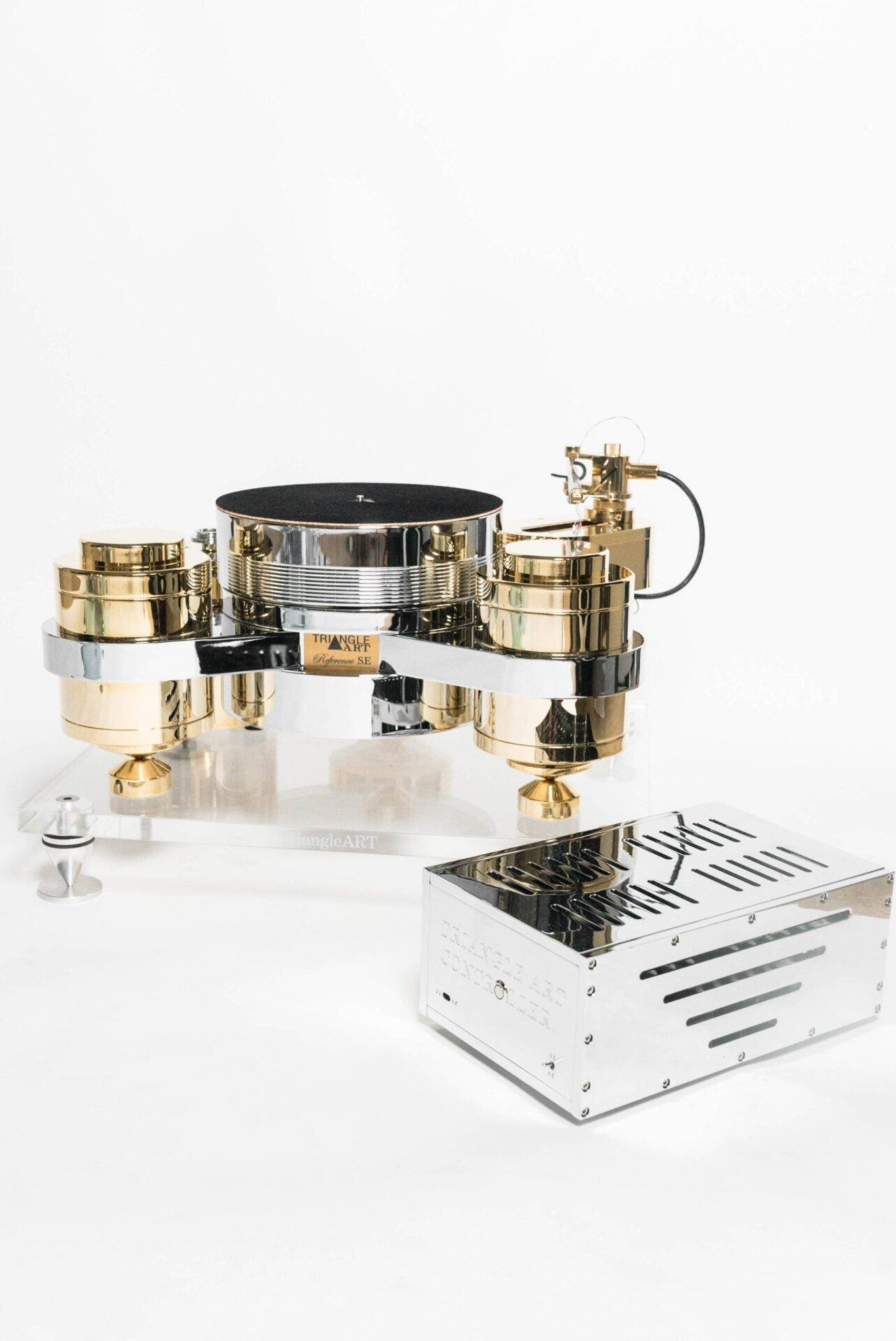
With the first LP played, a Jacintha 45rpm of ‘How Long Has This Been Going On’, it was apparent that this rig was different. There was a layer of analog velvet on not only the instruments but on her voice that just seemed “different”. The only way I can describe it was that it was more toward the tonality I hear from Master Tape playback. The soundstage was wide and tall with cymbals especially noted to be suspended in a nice three dimensional sound field. The most impressive thing about the cymbals was that there was clearly movement in the sound off of them, as the drummer hit and slid the drumsticks on the cymbals you could easily hear that movement, very nice. I quickly noticed that there was so much velvet here that I should probably change the loading on the Aesthetix Rhea phono preamp I was using. I checked and the Rhea was loaded at 10K ohms, I was getting a super sound so figuring the cartridge was new, I just left it there. During the next few albums I listened to it was apparent that I “may”have never heard a “new” cartridge sound so damn good. Yes there were the odd confused hard rock guitar wailings on the Led Zeppelin LP one would associate with a cartridge that wasn’t broken in but these were minor and fleeting. However on the new Reference Recording Stravinsky ‘The Firebird Suite/ The Song of the Nightingale’ the subtle passages were fleshed out while the dynamic passages were reproduced with all the slam that you hear with a live orchestra. Certainly no confusion was demonstrated by the “new” Concerto at all. On Jackson Browne’s ‘Running On Empty’ the live sound was captured with great authority and again I did not notice any issues from a new cartridge to speak of. I can only assume that with time and break in of the cartridge this rig will improve.
There is no denying that the Concerto was clearly swinging way above its weight class in this rig. As I played various jazz, classical, and of course some rock and all was sounding just great. A highlight was The Absolute Sound recommended LP, David Crosby’s ‘If I Could Only Remember My Name’. It has some great old hippie music on it and a wonderful giant soundstage. This was reproduced with amazing accuracy on the Triangle Arts table, huge dynamics and such a soundstage, quite enthralling. The dynamics on this table are absolutely first rate, earlier when I said everything had a layer of velvet I do not mean that there is any loss of detail, quite the contrary there is more detail than I could have imagined from a $14K table. I have been an analog guy setting up turntables since the late 60s and have had the luxury of attending many years of the best audio shows. I have heard almost every turntable there is, some at cost no object pricing, $50K, $75K, 100K, whatever and most of these I have actually heard many times. Some of them sound fantastic as you would expect, but friends at $14K the Triangle Arts Reference turntable is a force to be reckoned with. At this initial listening session I will go out on a limb and say that I doubt spending $50K or $70K on “some” (of course not all) of those turntables would really offer any better performance. That’s a big statement for a relatively unknown $14K table. Getting a turntable like the Triangle Arts Reference for only $14,000 will allow you to spend money on your system elsewhere. Be it a better arm, cartridge, or phono preamp, if the turntable is doing a fantastic job at this price add a Clearaudio Goldfinger cartridge ($12K), or a Clearaudio TT2 linear arm ($10K), I bet that would get exciting!
I have on the highest recommendation of Tom Vu of KT Audio Imports also ordered his special record clamp ($800) for the TA Reference; I don’t think I am going to start doubting him at this point. So I will report on that addition for this system in my follow up review. Also I will have the new Clearaudio Titanium ($8000) on the table and broken in before my follow up. Please feel free to ask me any questions that I can assist with.
Greg Beron
